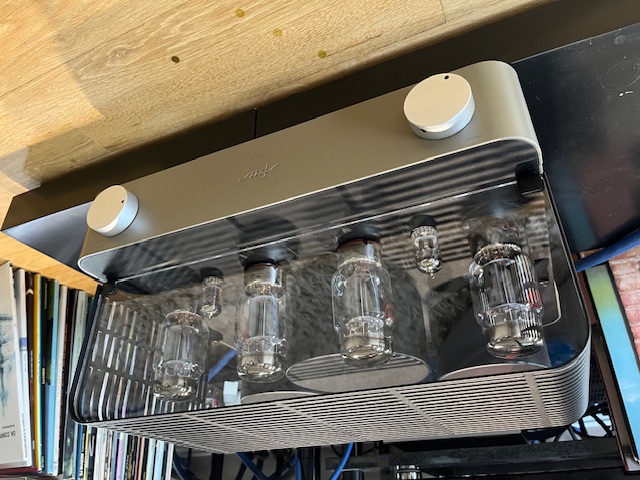Fezz Audio - Evo Titania Integrated Amp
Dave McNair has a blast listening to an affordable 45-watt-per-channel integrated amp cooked up à la polonaise.
Glass Bottle Love, Polish Style
For audiophiles on a limited budget the choices have never been more fantastic. Especially for the folks who want to find out what all the noise is about regarding vacuum tubes.
A glut of affordable (some ridiculously so), vacuum-tube-based, integrated amps have recently appeared on the market. Most are from companies located in China, South Korea, and other parts of East Asia, but in the last several years, more and more of these glowing glass bottle beauties have been coming out of Poland.
Fezz Audio out of Poland joined the party around 2015 but now has American distribution through Bluebird Music, and things are heating up. Their lineup and prices show that Fezz has the most affordable and comprehensive series of vacuum tube amplifiers of all the East Euro offerings, including a number of single ended triode equipped designs of various flavors.
The EVO Titania is the latest version of Fezz’s integrated, push-pull KT-88 pentode, 45 wpc design. A basic EVO Titania, as tested, has an MSRP of $3,995. It’s available in seven color schemes. Additional special order options at $300 each include Home Theater input, Bluetooth input, and subwoofer outputs.
It’s no secret that simple tube circuits built cost-efficiently can sound great. It’s not only more challenging to make a musically satisfying integrated amp using solid-state; you have to try hard to mess up a simple, tube-based design. And when good ears in the design team are involved in assessing and deciding what’s most important for sonics, inevitable compromises for a price point can produce a shockingly good amplifier—case in point: the Audio Research i50.
My interest started when a good friend and trusted local hifi dealer, Chris Livengood, owner of Ember Audio + Design, hipped me to the Titania. I borrowed one to take home from the shop, and shazam, I heard enough to want to do a full review. Many thanks to Jay Rein, Richard Colburn and the crew at Bluebird Music for facilitating.
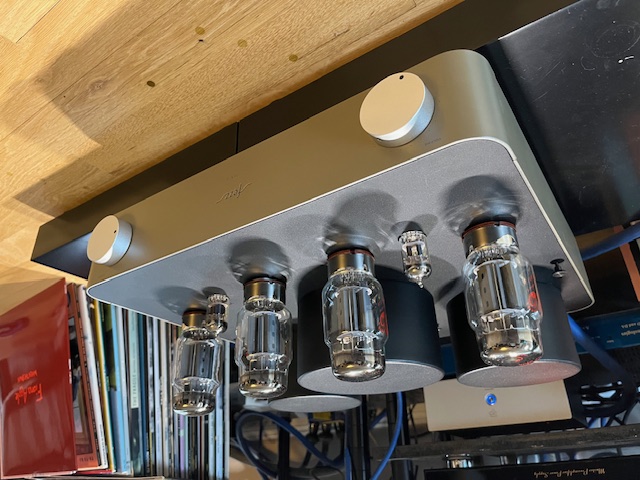
Back Story and Design Concept
Maciej Lachowski of Fezz Audio was kind enough to answer my questions regarding the company and the EVO Titania.
Dave McNair: How did you get into making amplifiers, and what were the circumstances around starting Fezz?
We’re all music lovers. From our very early years, our father, Lech, founder of the company, and our mom, Barbara, paid great attention to music. We had a huge collection of vinyl records and cassettes. Our parents also took us to many concerts. Me and my brother Tomasz always tried to make sure that the music in our home sounded as good as possible. As we grew up and finished Technical Academy in the city of Bialystok (where we still live) this fascination turned into a desire to build our own hifi. In 2015, we presented our first integrated amplifier, Silver Luna, under the brand Fezz, at the Audio Video Show in Warsaw.
Today, Fezz hires over 40 people to work during each shift in our production hall and use state-of-the-art equipment and software to produce and design our amplifiers, as well as to produce the transformers for them.
D.M: Does the design process include listening to and adjusting a circuit or parts to get a desired sonic outcome or is it primarily arrived at with measurements? Who is the primary designer behind the Titania?
There is no primary designer. It is a very complex process in which many people are involved. Listening sessions are fundamental to achieving a final, universal sound. Every change in the circuit can be crucial. That is why soundcheck is a must. Our goal is to achieve the perfect balance that complements the musical taste of most audio lovers. Measurements are important, but the sound is essential.
What influenced the use of toroidal transformers? Why don’t we see them more often in vacuum tube designs?
At Fezz, we believe the output transformers are the most important element in a vacuum tube amplifier. We’re manufacturing transformers for all Fezz amps in our factory. All of them are toroidal. Toroidal output transformers introduce the benefits of toroidal cores to the tube output. Through the use of an innovative, internationally patented winding technology, we have achieved exceptional electrical parameters, such as flat frequency bandwidth within the acoustic range, very low THD distortion, and a high sound quality factor.
So, why don’t we see them more often in vacuum tube designs? We see toroidal transformers in a power supply pretty often, but not as output transformers. The first reason is that toroidal output transformers are complicated to wind. Second, toroidal output transformers for single-ended constructions need to be air-gapped which is also not simple and needs a special, patent-covered technology, Third, we’re the owners of this patent.
D.M.: How is it possible to get such a high level of sonic performance at such a reasonable price?
At Fezz, we’ve focused on independence and the ability to produce as many elements as possible on our own. Thanks to this, we have achieved a very positive price/quality ratio for our devices.
D.M.:Can you tell me about the design of Titania? The manual mentioned auto bias so I assume a cathode bias circuit. Does the Titania use any local feedback in spots? If so, how much? What influenced the use of KT-88s in this design? Does the output transformer and power supply have enough capacity to run other power tubes? KT-120-150-170? Do you encourage or approve of “tube rolling”?
The design of Titania is quite simple. Our goal was to not slow down sound dynamics in an overly complicated design. The whole circuit consists of 3 stages: RC-coupled voltage amplifier (1/2 12AX7), split load phase inverter (1/2 12AX7), and ultra-linear power amplifier (2xKT88). Cathode bias is used primarily because it is inherently self-balancing, therefore any mismatched tubes, inserted by the user as a replacement or as an upgrade do not cause the output transformer core to saturate. Its purpose is mainly user convenience - although fixed bias allows more power from the same tubes, it would require periodical checks and adjustments.
Local feedback is used generously: in 1st and 2nd stages there is cathode degeneration, and in the output stage, there is ultra-linear coupling. The degree of local feedback in the voltage amplifying stage is moderate, however, the phase splitter works with 100% degeneration (its amplification factor is 1). Consequently, its frequency response is wide, and nonlinear distortion is extremely low. UL taps are located at a 43% turn ratio, providing a deep reduction of output impedance and non-linear distortion, also enhancing frequency response.The choice of KT88 is based on several reasons. It is one of the finest audio tubes ever made, considering the power capabilities and high linearity. It is well suited for an amplifier capable of several dozen watts, easily provided. Of course, it can do more - but it was not the case to squeeze every last watt out of it - we insist on the highest possible sound quality instead. Other beam power tubes from the KT family (KT120, KT150, and KT170) are compatible. It is entirely safe to insert them into the Titania amplifier. However, one receives no more power than with initial tubes, because the power supply, output transformers, and remaining circuitry are designed for 45 W.
For the driver tube (12AX7/ECC83) there are also numerous possible substitutions from different manufacturers which critically affect the sound.
D.M.: What are your thoughts about a single-ended instead of a balanced output (or input)? Is the Titania all single-ended to keep the build cost low?
In modern hifi, most of the connections between sources and integrated amplifiers use unbalanced RCA connections. XLR balanced connections are more often used by users of more advanced hifi systems which consist of power amplifiers or mono blocks. We plan to implement XLR connections in future models of Fezz power amps.
D.M.: What kind of music do you enjoy? What is your preferred source, vinyl or digital? What does your home system consist of? Is there a system set up at Fezz for evaluating designs? What does it consist of?
I don`t have any specific music genre that I listen to. I have a diverse musical taste. I really enjoy well-recorded rock or blues, and exploring new genres like world music, high-quality pop, and electronic music. I often pay attention to the production quality of the music. I appreciate albums, that have been carefully engineered and produced, with a focus on capturing the essence of the artist's performance. The source type is not crucial for me, the most important is quality music. Of course, vinyl adds an extra layer of enjoyment to my music-listening ritual, and I enjoy it very much.
My home system consists of Fezz Titania, Fezz Gratia phono stage, Klipsch Cornwall speakers, turntable, CD player, and Fezz Equinox DAC.
Put On A Record And Pass Me A Pierogi
 Warsaw restaurant Pierogi
Warsaw restaurant Pierogi
Before I get into sonics, a quick functional overview. Three RCA inputs, with front panel knob selector, a volume knob, and binding posts for 4ohm and 8ohm output transformer taps. A remote for volume is included. That’s it! The Titania is self biasing so no meters or test points.
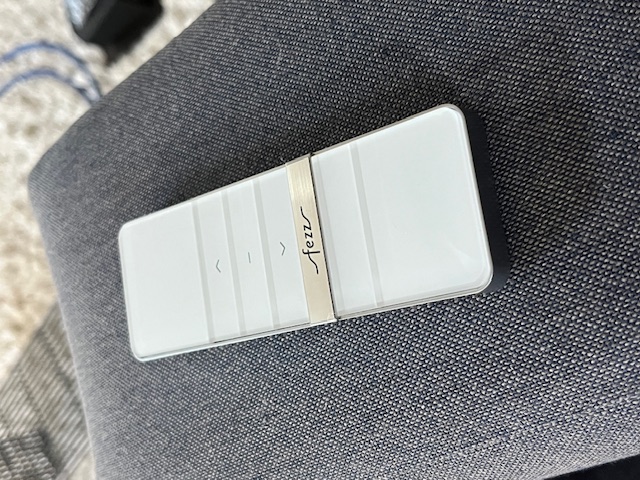
I first used the Titania with a pair of Qln Prestige Five loudspeakers. Then later my system underwent a dramatic shift when I acquired a pair of Acora Acoustics VRC speakers. So, I got to hear the Titania driving two different speaker systems.
Several listening impressions emerged on both loudspeakers. Even as the efficiencies of the P5s and VRCs differ, the Titania had no problems powering the 89db or so P5s. The amped laughed at driving the 94db VRCs (although I think that is quite a conservative rating). After a quick A/B, I used the 4ohm posts for both speakers.
Regardless of the speaker system, my ears were greeted by an instantly apparent display of dynamic prowess. 45 watts? Really? Large-scale dynamic shifts in the music almost seemed accentuated as much as subtle, microdynamic shades. I hate that term, but it serves its purpose for descriptions. I’ve written before that you don't know what you're missing until you hear a system capable of reproducing an unconstrained sense of dynamic contrast. The Titania ruled in this department, yet with a sense of ease commonly found in only the best vacuum tube and solid-state designs.
I listened primarily to my drug of choice, you guessed it, vinyl. The current rig is a TW Acustic Raven LS, Raven 10.5 tonearm, and mostly a Dynavector XV-1t. Of course, I streamed a fair amount of digital to get the entire lay of the land, but playing records on my current system is a sublime experience that I can’t seem to get enough of. The Fezz Audio integrated amp took nothing away from my platter party sessions in terms of enjoyment. Some nights, I’d have to switch back to my reference VAC Master and Ampsandsound Zion Monos, just to make sure I wasn’t crazy. Yep, those components presented my favorite tunes in a more refined, linear, and detailed manner, but the Titania was embarrassingly close.
Using digital was helpful because I could use the same source for either setup to make a fair comparison. Most of my impressions were buttressed by playing digital sources. Since the Titania does not contain a phono pre, when spinning records, I used a Lab 12 - Melto 2 phono pre because it was the only thing I had in hand equipped with unbalanced outputs. Still, the Melto 2 ain’t no slouch, and I enjoyed playing vinyl more than streaming.
It didn’t matter whether I played the best of minimally miked, classic analog recorded classical material, or heavily compressed modern rock a la Radiohead, the Fezz amp seemed to love it all.
The big dynamic capability, especially when using the Acoras, was a thrill on large-scale orchestral pieces from Mahler to Stravinsky.
The Titania's shortcomings are sins of omission rather than too much color, which is sometimes heard in tube amps as too thick and chunky soup. This was more apparent when listening to modern compressed music, which is already a thick stew. I could easily pick out the many Ed O’Brien guitar parts on even the densest tunes on OK Computer just as easily as I could hear back-of-the-stage percussion or viola parts in well-recorded symphonic selections.
Tonality and texture were portrayed with a familiar tube mojo that contributed to the to-die-for string tone of Heifitz on the Classic Records reissue of the Reiner/CSO Tchialkovski Violin Concerto.
Imaging-wise, the Titania anchored center image vocals on par with the best I’ve heard while taking nothing away from wide-panned musical parts on tunes such as Michael Jackson’s "Don’t Stop Till You Get Enough" from Off The Wall.
I did notice a slight excess of high-bass energy in the 100-200hz area. And the wispy air above 10-12Khz is not quite as apparent as in some pricy tube amps. This is not to say the Titania sounds rolled off or romantic, but it is definitely musically listenable instead of mission-critical accuracy.
Another element of the sonics that was less in the category of accurate or transparent (yet engaging and addictive) was Titania’s tendency to make midrange elements in a recording more immediate. Not forward in a negative sense, nor remotely strident, and not an obvious frequency response aberration, but in the time-honored Pro Audio terminology known as In Your Face. Maybe it was about the elevated sense of dynamics, coupled with a typical .2% THD as opposed to .002%, but it was NICE.
Okay, for completeness, the low end was plenty controlled for my likes, but not quite the grip and speed of a quality solid-state amp or a high-end tube job, but hey - whadda ya want for $3,995? The bass guitar/bass drum combo on pretty much all of XTC's Engish Settlement was large but defined enough to hear when Colin Moulding and Terry Chambers occasionally don't perfectly mesh. It was after all the pre-Pro Tools days.
Both speakers I used have quite a benign impedance curve, so I can’t comment on how well a Titania will drive something with 1 or 2-ohm dips. Try before you buy is my mantra.
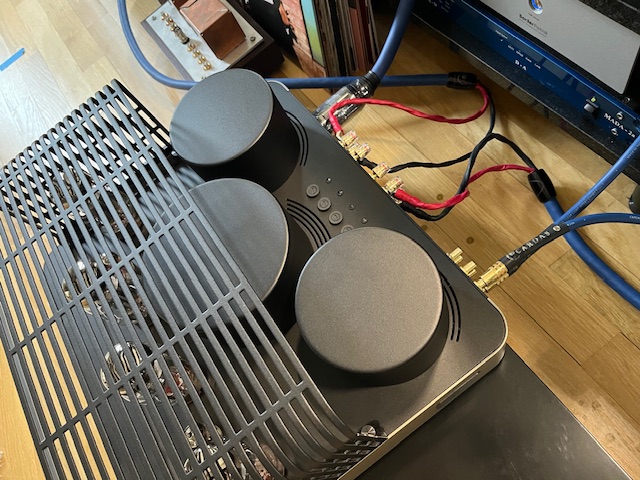
Wrap It Up
This integrated amp is an unqualified slam dunk for someone looking to get into what the best of vacuum tubes can do. The entry-level price is simply the perfect milk froth on top of a killer espresso shot. Make mine an oat milk cortado.
I suspect the Fezz Audio EVO Titania will turn out to be quite a gateway drug for an unsuspecting music lover who doesn’t realize they are about to become immersed in The Hobby. It’s almost unfair to the Titania to think of it only in terms of entry-level gear, but throw in a pair of decent used speakers, a Technics or Rega ‘table, and one of many solid sub-$1,000 phono pres or days (if you must) and you’re off to the races. Enjoy!
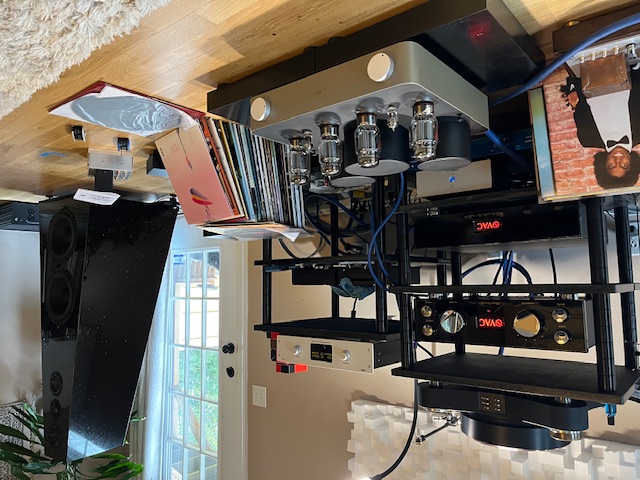
Specifications
Output :
2 x 45W
Type:
Push-pull class AB1
Output Impedance:
4 Ohm / 8 Ohm
Inputs:
3 x RCA
Autobias:
Auto
Harmonic distortions THD:
< 0,2%
Frequency response:
18Hz-103kHz (-3dB)
Power consumption:
225W
AC fuse:
3,15A T
Net weight:
17,5 kg
Dimensions:
420x380x200 mm
Tubes:
KT88 x 4 (power output), ECC83 (12AX7) x 2 (pre-amplifier and power drivers)
Manufacturer Information
Fezz Audio
Kolonia Koplany 1E
16-061 Juchnowiec Kościelny, Poland
info@fezzaudio.com
+48 724 430 404
North American Distribution:


